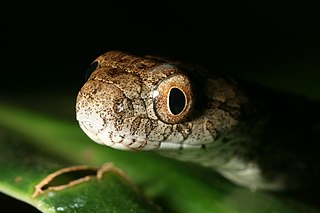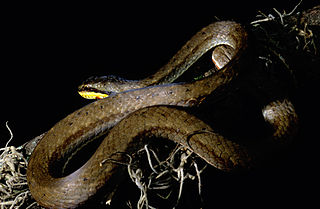
Colubridae is a family of snakes. With 249 genera, it is the largest snake family. The earliest fossil species of the family date back to the Late Eocene epoch, with earlier origins suspected. Colubrid snakes are found on every continent except Antarctica.

Clelia is a genus of snakes, one of three genera with species with the common name mussurana or musurana. Clelia is a genus of large snakes in the family Colubridae. The genus is native to Central America and South America, and species of Clelia are found from southern Mexico to Brazil. They specialize in ophiophagy, i.e., they attack and eat other snakes. Currently seven species are recognized as being valid. They have other popular names in various countries, such as zopilota in Central America and cribo on some Caribbean islands.

Chelodina, collectively known as snake-necked turtles, is a large and diverse genus of long-necked chelid turtles with a complicated nomenclatural history. Although in the past, Macrochelodina and Macrodiremys have been considered separate genera and prior to that all the same, they are now considered subgenera of the Chelodina, further Macrochelodina and Macrodiremys are now known to apply to the same species, hence Chelydera is used for the northern snake-necked turtles.

James Ray Dixon was professor emeritus and curator emeritus of amphibians and reptiles at the Texas Cooperative Wildlife Collection at Texas A&M University. He lived in El Campo, Texas, throughout most of his childhood. He published prolifically on the subject of herpetology in his distinguished career, authoring and co-authoring several books, book chapters, and numerous peer reviewed notes and articles, describing two new genera, and many new species, earning him a reputation as one of the most prominent herpetologists of his generation. His main research focus was morphology based systematics of amphibians and reptiles worldwide with emphasis on Texas, US, Mexico, Central America, and South America, although bibliographies, conservation, ecology, life history and zoogeography have all been the subjects of his extensive publications.
Proatheris is a monotypic genus created for the viper species, Proatheris superciliaris. This is a small terrestrial species endemic to East Africa. Like all other vipers, it is venomous. No subspecies are currently recognized.
Plasmodium wenyoni is a parasite of the genus Plasmodium. As in all Plasmodium species, P. wenyoni has both vertebrate and insect hosts. The vertebrate hosts for this parasite are reptiles.

Thamnodynastes pallidus, the Amazon coastal house snake, is a species of snake in the family Colubridae. The species is endemic to South America.

Dryophylax hypoconia is a species of snake in the family Colubridae. The species is endemic to South America.

Dryophylax almae is a species of snake in the family Colubridae. The species is endemic to Brazil.
Dryophylax ceibae is a species of snake in the family Colubridae. The species is endemic to Venezuela.
Dryophylax chimanta is a species of snake in the family Colubridae. The species is endemic to Venezuela and only known from the Chimantá tepui.
Zonateres is a genus of snake in the subfamily Dipsadinae of the family Colubridae. The genus is monotypic, containing the sole species Zonateres lanei, which is native to South America.
Dryophylax dixoni is a species of snake in the family Colubridae. The species is endemic to Venezuela and Colombia.
Dryophylax marahuaquensis is a species of snake in the family Colubridae. The species is endemic to Venezuela.
Dryophylax nattereri, the Amazon coastal house snake or northern coastal house snake, is a species of snake in the family Colubridae.

Dryophylax paraguanae is a species of snake in the family Colubridae. The species is endemic to Venezuela and Colombia.
Dryophylax phoenix is a species of snake in the family Colubridae. The species is endemic to Brazil.
Dryophylax yavi is a species of snake in the family Colubridae. The species is endemic to Venezuela.

Mesotes rutilus, Prado's coastal house snake, is a species of snake in the family Colubridae. The species is endemic to Brazil.









